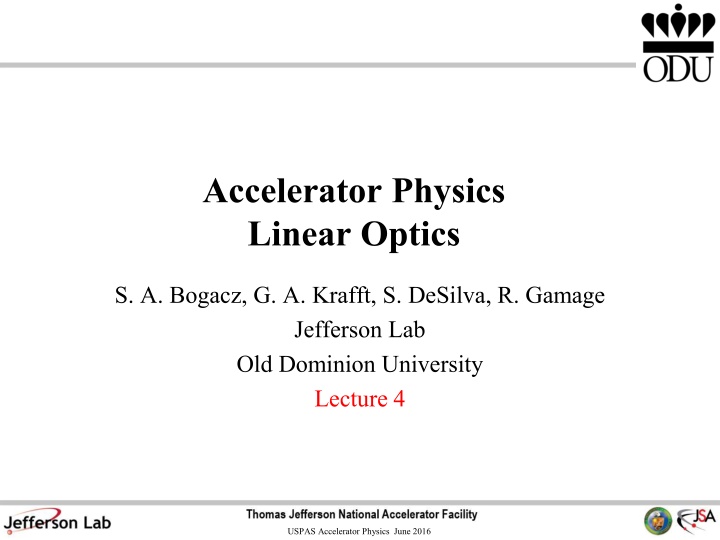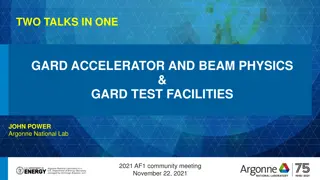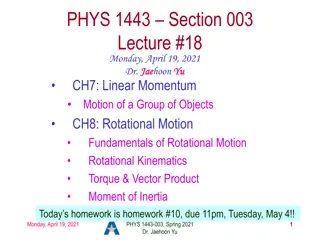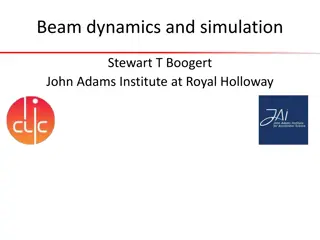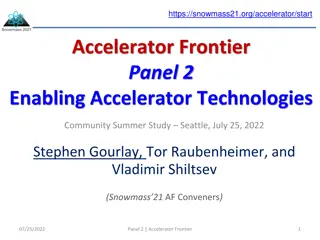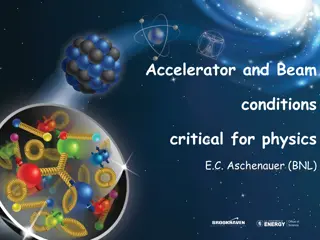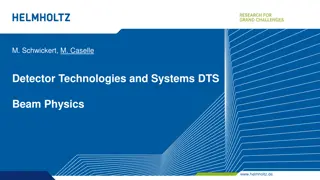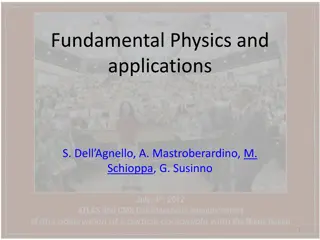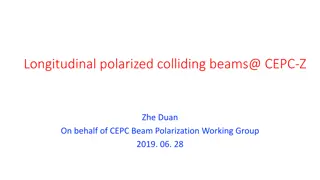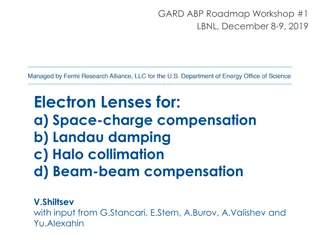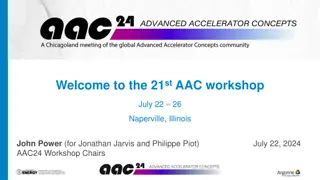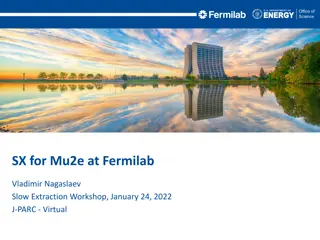Linear Beam Optics and Particle Motion in Accelerator Physics
Explore the fundamental concepts of linear beam optics and particle motion in accelerator physics, covering topics such as design trajectory, path length, phase advance, transfer matrix, and more. Understand the intricacies of designing accelerators and the mathematical representations involved in optimizing particle trajectories. Delve into the geometry of ellipses, Twiss representation, and the significance of path length in Earth-fixed reference frames. Gain insights into beam matching and the importance of curvature in accelerator design.
Download Presentation

Please find below an Image/Link to download the presentation.
The content on the website is provided AS IS for your information and personal use only. It may not be sold, licensed, or shared on other websites without obtaining consent from the author.If you encounter any issues during the download, it is possible that the publisher has removed the file from their server.
You are allowed to download the files provided on this website for personal or commercial use, subject to the condition that they are used lawfully. All files are the property of their respective owners.
The content on the website is provided AS IS for your information and personal use only. It may not be sold, licensed, or shared on other websites without obtaining consent from the author.
E N D
Presentation Transcript
Accelerator Physics Linear Optics S. A. Bogacz, G. A. Krafft, S. DeSilva, R. Gamage Jefferson Lab Old Dominion University Lecture 4 USPAS Accelerator Physics June 2016
Linear Beam Optics Outline Particle Motion in the Linear Approximation Some Geometry of Ellipses Ellipse Dimensions in the -function Description Area Theorem for Linear Transformations Phase Advance for a Unimodular Matrix Formula for Phase Advance Matrix Twiss Representation Invariant Ellipses Generated by a Unimodular Linear Transformation Detailed Solution of Hill s Equation General Formula for Phase Advance Transfer Matrix in Terms of -function Periodic Solutions Non-periodic Solutions Formulas for -function and Phase Advance Beam Matching USPAS Accelerator Physics June 2016
Linear Particle Motion Fundamental Notion: The Design Orbit is a path in an Earth- fixed reference frame, i.e., a differentiable mapping from [0,1] to points within the frame. As we shall see as we go on, it generally consists of arcs of circles and straight lines. :[0,1] = 3 R ( ) ( ) ( ) ( ) ( ) , , X X Y Z Fundamental Notion: Path Length 2 2 2 dX d dY d dZ d = + + ds d USPAS Accelerator Physics June 2016
The Design Trajectory is the path specified in terms of the path length in the Earth-fixed reference frame. For a relativistic accelerator where the particles move at the velocity of light, Ltot=cttot. 3 :[0, ] R s L tot ( ) ( ) ( ) ( ) ( ) = , , s X s X s Y s Z s The first step in designing any accelerator, is to specify bending magnet locations that are consistent with the arc portions of the Design Trajectory. USPAS Accelerator Physics June 2016
Comment on Design Trajectory The notion of specifying curves in terms of their path length is standard in courses on the vector analysis of curves. A good discussion in a Calculus book is Thomas, Calculus and Analytic Geometry, 4th Edition, Articles 14.3-14.5. Most vector analysis books have a similar, and more advanced discussion under the subject of Frenet-Serret Equations . Because all of our design trajectories involve only arcs of circles and straight lines (dipole magnets and the drift regions between them define the orbit), we can concentrate on a simplified set of equations that only involve the radius of curvature of the design orbit. It may be worthwhile giving a simple example. USPAS Accelerator Physics June 2016
4-Fold Symmetric Synchrotron x 1s s = 0 z 0 y vertical = + /2 s L 7s 2 x z = 3 s s 3s 6 2 L = 2 5s s s 4 2 USPAS Accelerator Physics June 2016
Its Design Trajectory ( ) = 0,0, 0 s s L s 1 ( ) ( ) ( ) ( ) ( ) + ( ) + ( 0,0, cos / 1,0,sin )( 2 s / L s s s s s s s 1 ) ( 1 1 2 ) + ( L ,0 , 1,0,0 L s s s s 2 3 ( L ) ( ) ( ) ) ( ) ( ) + + ,0, sin / ,0,cos / 1 L s s s s s s s 3 3 3 4 ( ) ( + )( ) )( 6 s ) ( L 2 ,0, 0,0, 1 ) ( ( ) 1,0,0 ( ) ( ) 7 / s L s ( s s s s 4 4 5 ( ) ( ) ) ) 2 ,0,0 + 1 cos / ,0, sin / s s s s s s s 5 5 5 6 ( ) ( + ( ,0, L s s s s 6 7 ) ( ) ( ) ( ) + ,0, sin / ,0,1 cos 4 s s s s s s 7 7 2 USPAS Accelerator Physics June 2016
Betatron Design Trajectory 3 :[0,2 ] R s R ( ) ( ) ( ) ( ) = cos / , sin R / ,0 s X s R s R s R Use path length s as independent variable instead of t in the dynamical equations. 1 d ds d = R dt c USPAS Accelerator Physics June 2016
Betatron Motion in s 2 d r p p ( ) + = 2 c 2 c 1 n r R 2 dt 2 d z + = 2 c 0 n z 2 dt ( ) 1 n 2 1 R p d r p + = r 2 2 ds R z 2 d n + = 0 z 2 2 ds R USPAS Accelerator Physics June 2016
Bend Magnet Geometry y B x Rectangular Magnet of Length L Sector Magnet x z /2 USPAS Accelerator Physics June 2016
Bend Magnet Trajectory For a uniform magnetic field ( ) d mV dt mV dt mV dt = + E V B ( ) d = x qV B z y ( ) d = qV B z x y 2 2 d V dt d V dt + = + = 2 c 2 c 0 0 x V V z x z 2 2 ( ) 0 ( ) 0 = = For the solution satisfying boundary conditions: 0 z 0 X V V z p ( ) ( ) ( ) ( ) ( ) = = = cos 1 cos 1 / X t t t qB m c c c y qB y p ( ) ( ) ( ) = = sin sin Z t t t c c qB y USPAS Accelerator Physics June 2016
Magnetic Rigidity The magnetic rigidity is: p q = = B B y It depends only on the particle momentum and charge, and is a convenient way to characterize the magnetic field. Given magnetic rigidity and the required bend radius, the required bend field is a simple ratio. Note particles of momentum 100 MeV/c have a rigidity of 0.334 T m. Normal Incidence (or exit) Dipole Magnet Long Dipole Magnet ( ) ( ) ( ) = B = B sin 2sin /2 BL BL USPAS Accelerator Physics June 2016
Natural Focusing in Bend Plane Perturbed Trajectory Design Trajectory Can show that for either a displacement perturbation or angular perturbation from the design trajectory 2 2 d x ds x d y ds y = = ( ) s ( ) s 2 2 y 2 2 x USPAS Accelerator Physics June 2016
Quadrupole Focusing ( ) ( )( ) B s = + , B x y xy yx v ds d v ds d ( ) ( ) qB s x qB s y y = = x m m ( ) B ( ) B B s B s 2 2 d x ds d y ds + = = 0 0 x y 2 2 Combining with the previous slide ( ) B ( ) B B s B s 2 2 1 1 d x ds d y ds + + = + = 0 0 x y ( ) s ( ) s 2 2 x 2 2 y USPAS Accelerator Physics June 2016
Hills Equation Define focusing strengths (with units of m-2) ( ) B ( ) B B s B s 1 1 ( ) s = + = k k ( ) s ( ) s x y 2 x 2 y 2 2 d x ds d y ds ( ) s x ( ) s y + = + = 0 0 k k x y 2 2 Note that this is like the harmonic oscillator, or exponential for constant K, but more general in that the focusing strength, and hence oscillation frequency depends on s USPAS Accelerator Physics June 2016
Energy Effects ( ) + 1 / p p p p p ( ) ( ) x s ( ) = 1 cos / s eB y This solution is not a solution to Hill s equation directly, but is a solution to the inhomogeneous Hill s Equations ( ) B B s 2 1 1 d x ds p p + + = x ( ) s ( ) s 2 2 x x ( ) B B s 2 1 1 d y ds p p + = y ( ) s ( ) s 2 2 y y USPAS Accelerator Physics June 2016
Inhomogeneous Hills Equations Fundamental transverse equations of motion in particle accelerators for small deviations from design trajectory ( ) B B s 2 1 1 d x ds p p + + = x ( ) s ( ) s 2 2 x x ( ) B B s 2 1 1 d y ds p p + = y ( ) s ( ) s 2 2 y y radius of curvature for bends, B' transverse field gradient for magnets that focus (positive corresponds to horizontal focusing), p/p momentum deviation from design momentum. Homogeneous equation is 2nd order linear ordinary differential equation. USPAS Accelerator Physics June 2016
Dispersion From theory of linear ordinary differential equations, the general solution to the inhomogeneous equation is the sum of any solution to the inhomogeneous equation, called the particular integral, plus two linearly independent solutions to the homogeneous equation, whose amplitudes may be adjusted to account for boundary conditions on the problem. ( ) ( ) ( ) ( ) 1 2 = p x x x s x s A x s B x s + + ( ) y s ( ) s ( ) ( ) s + + = y A y s B y 1 2 p y y Because the inhomogeneous terms are proportional to p/p, the particular solution can generally be written as p x s D s p where the dispersion functions satisfy ( ) ( ) x x s B s p p ( ) ( ) ( ) s ( ) s = = y D p x p y ( ) B B s B s 2 d D ds 2 1 1 1 1 d D ds y + + = + = x D D ( ) ( ) s ( ) s x y 2 2 2 2 y y USPAS Accelerator Physics June 2016
M56 In addition to the transverse effects of the dispersion, there are important effects of the dispersion along the direction of motion. The primary effect is to change the time-of- arrival of the off-momentum particle compared to the on-momentum particle which traverses the design trajectory. ds p p ( ) = + z D s ds ds p ds p ( ) ( ) = d z D s ( ) s p p ( ) ( ) + D s Design Trajectory Dispersed Trajectory ( ) ( ) s ( ) ( ) s s D s D s 2 y = + x M ds 56 x y s 1 USPAS Accelerator Physics June 2016
Solutions Homogeneous Eqn. Dipole ( ) ( ) s ds ( ) ( ) s ds ( ( ) / ( ( ) x s dx x s dx ( s ) / ( s ) / cos / sin / s s s s i i i = ( ) ( ) ) ) sin cos s s i i i Drift ( ) ( ) s ( ) ( ) s ds x s dx ds x s dx 1 0 s s i = i 1 i USPAS Accelerator Physics June 2016
B B = Quadrupole in the focusing direction / k ( ) ( ) ( ) ( ) s ( ) ( ) s ds ( ) ( ) x s dx ds x s dx cos sin / k s s k s s k i i i = ( ) ( ) ( ) ( ) sin cos k k s s k s s i i i B B = Quadrupole in the defocusing direction / k ( ) ( ) ( ) ( ) s ( ) ( ) s ds ( ) ( ) x s dx ds x s dx cosh sinh / k s s k s s k i i i = ( ) ( ) ( ) ( ) sinh cosh k k s s k s s i i i USPAS Accelerator Physics June 2016
Transfer Matrices Dipole with bend (put coordinate of final position in solution) ( ( after s ds ) ( ) x s x s ( ) ( ) ( ) ( ) cos sin sin cos after before = dx dx ds ) ( ) / before s Drift ( ) ( ) x s x s 1 0 L after before = drift dx ds dx ds ( ) ( ) 1 after s before s USPAS Accelerator Physics June 2016
Thin Lenses f f Thin Focusing Lens (limiting case when argument goes to zero!) ( ) ( ) 1/ lens s ds ( ) + x s dx x s dx ds 1 0 1 lens lens = ( ) + f lens s Thin Defocusing Lens: change sign of f USPAS Accelerator Physics June 2016
Composition Rule: Matrix Multiplication! Element 1 Element 2 1s 0s 2s ( ) ( ) x s ( ) ( ) x s ( ) ( ) 2 x s ( ) ( ) x s ( ) ( ) x s x s x s x s x s 1 0 2 1 = = M M 1 2 1 0 2 1 ( ) ( ) x s x s x s 2 0 = M M 2 1 0 More generally = ... M M M M M 1 2 1 tot N N Remember: First element farthest RIGHT USPAS Accelerator Physics June 2016
Some Geometry of Ellipses y Equation for an upright ellipse 2 2 b x y + = 1 a x a b In beam optics, the equations for ellipses are normalized (by multiplication of the ellipse equation by ab) so that the area of the ellipse divided by appears on the RHS of the defining equation. For a general ellipse + + = 2 2 2 Ax Bxy Cy D USPAS Accelerator Physics June 2016
The area is easily computed to be Area D = Eqn. (1) 2 AC B So the equation is equivalently + 2 + = 2 2 x xy y A B C = = = , , and 2 2 2 AC B AC B AC B USPAS Accelerator Physics June 2016
When normalized in this manner, the equation coefficients clearly satisfy 2= 1 Example: the defining equation for the upright ellipse may be rewritten in following suggestive way b a + = = 2 2 x y ab a b = a = =b = , x ymax = a/b and = b/a, note max USPAS Accelerator Physics June 2016
General Tilted Ellipse y Needs 3 parameters for a complete description. One way y=sx b a b ( ) 2 + = = 2 x y sx ab x a b a where s is a slope parameter, a is the maximum extent in the x-direction, and the y-intercept occurs at b, and again is the area of the ellipse divided by + 1 2 b a a a + = = 2 2 2 2 s x s xy y ab 2 a b b b USPAS Accelerator Physics June 2016
Identify + 1 2 b a a a = = = 2 , , s s 2 a b b b Note that 2 = 1 automatically, and that the equation for ellipse becomes ( ) 2 + + = 2 x y x by eliminating the (redundant!) parameter USPAS Accelerator Physics June 2016
Ellipse in the -function Description , y y=sx= x / , = / b x = a = = , x y As for the upright ellipse max max USPAS Accelerator Physics June 2016
Area Theorem for Linear Optics Under a general linear transformation ' M M x x 11 12 = ' M M y y 21 22 an ellipse is transformed into another ellipse. Furthermore, if det (M) = 1, the area of the ellipse after the transformation is the same as that before the transformation. Pf: Let the initial ellipse, normalized as above, be + x + = 2 2 2 xy y 0 0 0 0 USPAS Accelerator Physics June 2016
Effect of Transformation + + = 2 2 2 x xy y Let the final ellipse be The transformed coordinates must solve this equation. x y + + = 2 2 2 x y ( ) , x y M + + = 2 2 2 x xy y ( ) 0 0 0 0 x y , M 1 ' ' M M M M x y x y 11 12 = 21 2 2 1 1 x y x y M M M M = 11 12 The transformed coordinates must also solve the initial equation transformed. 1 1 21 22 USPAS Accelerator Physics June 2016
Because ( ( ) ) ( ( ) ) 1 1 M M ' ' x y x y 11 12 = 1 1 M M 21 22 The transformed ellipse is + + = 2 2 2 x x y y 0 ( ) ( ) ( ) ) ( 12 ) ( ) 2 2 = + + 1 1 1 1 2 M M M M 0 0 0 11 11 21 21 ( ) ) ) ( ) ( 11 ) ( ) ( 11 ( ) ( 12 ) ( ) ( 21 ) = + + + 1 1 1 1 1 1 1 1 M M M M M M M M 0 0 0 12 22 21 22 ( ( ) ( 2 2 = + + 1 1 1 1 2 M M M M 0 0 0 12 22 22 USPAS Accelerator Physics June 2016
Because (verify!) ( ) = 2 2 0 0 0 ) ( ( ) ( 21 ) ( ) ( 11 ) )( ( ) ( 11 ) ( 22 ) ( 12 ) 2 2 2 2 + 1 1 1 1 1 1 1 1 2 M M M M M M M M 12 22 21 ( ) 2 = 2 0 1 det M 0 0 the area of the transformed ellipse (divided by ) is, by Eqn. (1) Area = = = 0 | det | M 0 2 0 1 det M 0 0 USPAS Accelerator Physics June 2016
Tilted ellipse from the upright ellipse In the tilted ellipse the y-coordinate is raised by the slope with respect to the un-tilted ellipse = s y ' ' 1 0 x x 1 y b a a b ( ) = = = = 1 , 0, , M s 0 0 0 21 b a a a = + = = 2 , , s s a b b b Because det (M)=1, the tilted ellipse has the same area as the upright ellipse, i.e., = 0. USPAS Accelerator Physics June 2016
Phase Advance of a Unimodular Matrix Any two-by-two unimodular (Det (M) = 1) matrix with |Tr M| < 2 can be written in the form 1 0 ( ) ( ) = + cos sin M 0 1 The phase advance of the matrix, ,gives the eigenvalues of the matrix = e i , and cos = (Tr M)/2. Furthermore 2=1 Pf: The equation for the eigenvalues of M is ( ) + + = 2 1 0 M M 11 22 USPAS Accelerator Physics June 2016
Because M is real, both and * are solutions of the quadratic. Because ( ) 2 Tr M ( ( ) )2 = 1 Tr / 2 i M For |Tr M| < 2, * =1 and so 1,2 = e i . Consequently cos = (Tr M)/2. Now the following matrix is trace-free. = 1 0 2 M M 11 22 M 1 0 12 ( ) cos M 2 M M 22 11 M 21 USPAS Accelerator Physics June 2016
Simply choose M M M M = = = , , 11 22 12 21 2 sin sin sin and the sign of to properly match the individual matrix elements with > 0. It is easily verified that 2 = 1. Now and more generally 1 0 ( ) ( ) = 2 + 2 2 cos sin M 0 1 1 0 ( ) ( ) = n + n Mn cos sin 0 1 USPAS Accelerator Physics June 2016
Therefore, because sin and cos are both bounded functions, the matrix elements of any power of M remain bounded as long as |Tr (M)| < 2. NB, in some beam dynamics literature it is (incorrectly!) stated that the less stringent |Tr (M)| 2 ensures boundedness and/or stability. That equality cannot be allowed can be immediately demonstrated by counterexample. The upper triangular or lower triangular subgroups of the two-by-two unimodular matrices, i.e., matrices of the form 1 0 1 1 x 0 x or 1 clearly have unbounded powers if |x| is not equal to 0. USPAS Accelerator Physics June 2016
Significance of matrix parameters Another way to interpret the parameters , , and , which represent the unimodular matrix M (these parameters are sometimes called the Twiss parameters or Twiss representation for the matrix) is as the coordinates of that specific set of ellipses that are mapped onto each other, or are invariant, under the linear action of the matrix. This result is demonstrated in Thm: For the unimodular linear transformation 1 0 ( ) ( ) = + cos sin M 0 1 with |Tr (M)| < 2, the ellipses USPAS Accelerator Physics June 2016
+ + = 2 2 2 x xy y c are invariant under the linear action of M, where c is any constant. Furthermore, these are the only invariant ellipses. Note that the theorem does not apply to I, because |Tr ( I)| = 2. Pf: The inverse to M is clearly 1 0 ( ) ( ) = 1 cos sin M 0 1 By the ellipse transformation formulas, for example ( ( ( ( = + = cos sin ) + )( ) + ( ) 2 = 1 + sin + + cos + + 2 2 ' sin 2 sin cos sin cos sin ) ) = 2 2 2 2 2 2 2 2 sin sin 2 2 USPAS Accelerator Physics June 2016
Similar calculations demonstrate that ' = and ' = . As det (M) = 1, c' = c, and therefore the ellipse is invariant. Conversely, suppose that an ellipse is invariant. By the ellipse transformation formula, the specific ellipse + 2 xy x i i + = 2 2 y i is invariant under the transformation by M only if ( ) ( )( 2 ) ( ) )( 2 2 cos sin 2 cos sin sin sin i i ( )( 2 ) ( ) = + cos sin sin 1 2 + sin cos sin + sin 2 i i ( ) ( )( ) ( ) sin 2 cos sin sin cos sin i i i , T T v M i M i USPAS Accelerator Physics June 2016
v i.e., if the vector is ANY eigenvector of TM with eigenvalue 1. All possible solutions may be obtained by investigating the eigenvalues and eigenvectors of TM. Now solution w a has = v v T M i.e., ( ) = hen Det 0 T I M ( )( ) + 2 4cos + = 2 2 1 1 0 Therefore, M generates a transformation matrix TM with at least one eigenvalue equal to 1. For there to be more than one solution with = 1, + + = = = 2 2 1 2 4cos 1 0, cos 1, or M I USPAS Accelerator Physics June 2016
and we note that all ellipses are invariant when M = I. But, these two cases are excluded by hypothesis. Therefore, M generates a transformation matrix TM which always possesses a single nondegenerate eigenvalue 1; the set of eigenvectors corresponding to the eigenvalue 1, all proportional to each other, are the only vectors whose components ( i, i, i) yield equations for the invariant ellipses. For concreteness, compute that eigenvector with eigenvalue 1 normalized so i i i2 = 1 = 1 i / M M 21 12 i ( ) = = / 2 v M M M , 1 11 22 12 i i = i/ v v c All other eigenvectors with eigenvalue 1 have , for some value c. 1 , 1 USPAS Accelerator Physics June 2016
v, 1 Because Det (M) =1, the eigenvector invariant ellipse Likewise, the proportional eigenvector generates the similar ellipse ( + 2 xy x c clearly yields the i + + = 1v 2 2 2 . x xy y ) = + 2 2 y Because we have enumerated all possible eigenvectors with eigenvalue 1, all ellipses invariant under the action of M, are of the form xy x + + 2 = 2 2 y c USPAS Accelerator Physics June 2016
To summarize, this theorem gives a way to tie the mathematical representation of a unimodular matrix in terms of its , , and , and its phase advance, to the equations of the ellipses invariant under the matrix transformation. The equations of the invariant ellipses when properly normalized have precisely the same , , and as in the Twiss representation of the matrix, but varying c. Finally note that throughout this calculation c acts merely as a scale parameter for the ellipse. All ellipses similar to the starting ellipse, i.e., ellipses whose equations have the same , , and , but with different c, are also invariant under the action of M. Later, it will be shown that more generally ' ' 2 x xx x = + + = ( ) / ( ) 2 + + 2 2 2 ' x x x is an invariant of the equations of transverse motion. USPAS Accelerator Physics June 2016
Applications to transverse beam optics When the motion of particles in transverse phase space is considered, linear optics provides a good first approximation of the transverse particle motion. Beams of particles are represented by ellipses in phase space (i.e. in the (x, x') space). To the extent that the transverse forces are linear in the deviation of the particles from some pre- defined central orbit, the motion may analyzed by applying ellipse transformation techniques. Transverse Optics Conventions: positions are measured in terms of length and angles are measured by radian measure. The area in phase space divided by , , measured in m-rad, is called the emittance. In such applications, has no units, has units m/radian. Codes that calculate , by widely accepted convention, drop the per radian when reporting results, it is implicit that the units for x' are radians. USPAS Accelerator Physics June 2016
Linear Transport Matrix Within a linear optics description of transverse particle motion, the particle transverse coordinates at a location s along the beam line are described by a vector ( ) ( ) ds x s dx s If the differential equation giving the evolution of x is linear, one may define a linear transport matrix Ms',srelating the coordinates at s' to those at s by ( ) ( ) ds ( ) ( ) s ds ' x s x s = dx dx M ' s s , ' s USPAS Accelerator Physics June 2016
From the definitions, the concatenation rule Ms'',s= Ms'',s'Ms',smust apply for all s' such that s < s'< s'' where the multiplication is the usual matrix multiplication. Pf: The equations of motion, linear in x and dx/ds, generate a motion with ( ) ( ) ( ) ds ds for all initial conditions (x(s), dx/ds(s)), thus Ms'',s= Ms'',s'Ms',s. ( ) s ' ' ( ) ( ) s ds ( ) ( ) s ds ' x s x x s x s = = = dx dx dx dx M M M M ' ' ' s s , ' ' , ' ' ' , ' ' ' , ' s s s s s s s s Clearly Ms,s= I. As is shown next, the matrix Ms',s is in general a member of the unimodular subgroup of the general linear group. USPAS Accelerator Physics June 2016
Ellipse Transformations Generated by Hill s Equation The equation governing the linear transverse dynamics in a particle accelerator, without acceleration, is Hill s equation* 2 d x ( ) s + = Eqn. (2) 0 K x 2 ds The transformation matrix taking a solution through an infinitesimal distance ds is ( ) ( ) ( ) s ( ) ( ) s ds + ds rad x s ds x s x s 1 = dx dx dx M ( ) + + s ds , s ds s ( ) s rad 1 K ds ds ds * Strictly speaking, Hill studied Eqn. (2) with periodic K. It was first applied to circular accelerators which had a periodicity given by the circumference of the machine. It is a now standard in the field of beam optics, to still refer to Eqn. 2 as Hill s equation, even in cases, as in linear accelerators, where there is no periodicity. USPAS Accelerator Physics June 2016
